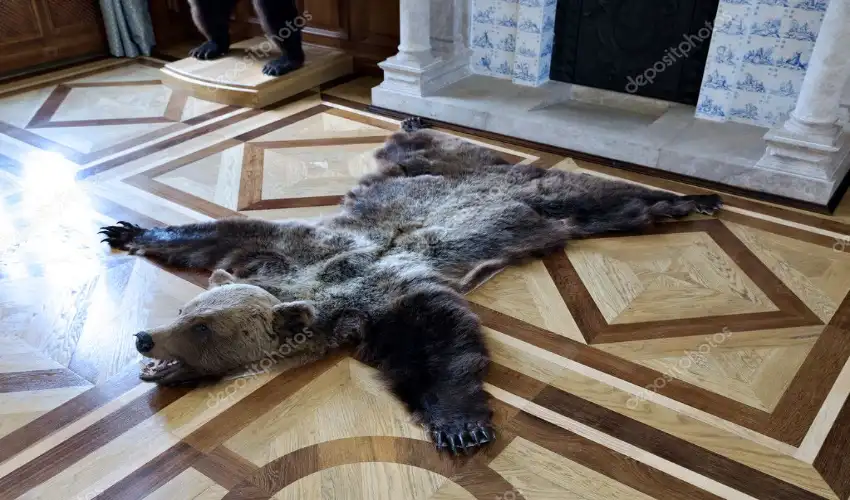Bear skin rugs have long been a symbol of luxury and rustic charm, often featured in upscale cabins, hunting lodges, and outdoor-themed spaces. These impressive pieces of art are not only stunning decor but also tell a story of craftsmanship that dates back centuries. But who makes these exquisite rugs, and how are they crafted? Let’s take a closer look at the fascinating process behind creating bear skin rugs.
The Makers of Bear Skin Rugs
The creation of a bear skin rug is typically entrusted to skilled artisans who specialize in taxidermy and rug-making. Taxidermists are the primary professionals responsible for preserving and preparing animal pelts for display. These artisans have a deep understanding of animal anatomy and an eye for detail to ensure that the bear’s natural beauty is captured in its final form.
Bear skin rug makers are often employed by taxidermy studios or independent craftsmen who have mastered the intricate skills of tanning and rug production. Many of these professionals have undergone years of training and possess extensive experience in working with animal pelts. Some artisans even travel to remote areas to source raw pelts directly from hunters, ensuring they select only the highest-quality specimens for their creations.
The Process of Crafting Bear Skin Rugs
Crafting a bear skin rug for sale involves several key stages, each requiring precision and skill. Let’s explore the steps that go into making these iconic rugs.
- Sourcing the Bear Pelt
The first step in creating a bear skin rug is acquiring a bear pelt. Bears are usually hunted legally in regulated environments, such as during hunting seasons or through controlled hunts. The pelt is then carefully harvested by professionals who are trained in animal skinning techniques. The quality of the bear pelt is paramount, as it will determine the final rug’s appearance, durability, and texture.
- Skinning the Bear
Once the bear is harvested, the pelt is carefully removed. This step is crucial, as it requires expertise to ensure the fur remains intact, and no damage is done to the hide. The skinning process involves making precise cuts along the body and removing the skin from the animal’s flesh. It is vital to keep the fur as intact as possible during this process to prevent damage that could affect the final product.
- Tanning the Pelt
After the pelt is removed, it must undergo a tanning process to preserve the hide. This step is necessary to prevent decomposition and to make the pelt more durable. The tanning process also helps soften the leather side of the pelt, making it easier to work with. There are different methods of tanning, but most taxidermists use either a chemical or natural tanning solution to preserve the bear skin. This process can take several weeks to complete, depending on the method used and the size of the pelt.
- Fleshing and Scraping
Once the tanning process is complete, the bear skin undergoes a fleshing and scraping stage. This step involves removing any remaining flesh, fat, and tissue from the skin to ensure that the rug will last for many years. The fleshing process requires a sharp tool to carefully scrape away any unwanted material without damaging the fur.
- Shaping and Mounting
With the pelt now properly preserved and cleaned, it is time to mount the bear skin onto a backing material. The mounting process involves stretching the skin to achieve a flat, even surface, allowing the bear’s features to be displayed in a natural and lifelike way. The skin is typically tacked or sewn into place onto a sturdy backing such as canvas or leather.
At this stage, the head and feet of the bear are often sculpted to create a more realistic appearance. This requires meticulous attention to detail, as the bear’s features need to be positioned correctly to mimic its natural posture.
- Finishing Touches
After the bear skin is mounted, it’s time for the finishing touches. This stage involves trimming and grooming the fur to create a smooth, uniform look. The taxidermist will carefully shape the bear’s face and arrange the claws and teeth for a more authentic appearance. Some rug makers also apply protective coatings to the pelt to ensure it retains its luster and is resistant to wear and tear.
Finally, the bear skin is attached to a soft, plush backing to create a comfortable and durable rug that can be placed on the floor. The rug may be framed with leather or decorative edging to enhance its visual appeal and ensure it holds its shape.
The Care and Maintenance of Bear Skin Rugs
Once completed, bear skin rugs require proper care to maintain their appearance and longevity. To preserve the fur, it is essential to regularly clean the rug using a vacuum or soft brush. Exposure to direct sunlight can cause the fur to fade over time, so it is recommended to place the rug in a shaded area.
Bear skin rugs should also be professionally cleaned if they become heavily soiled. Regular inspections for any signs of wear or damage can help prevent further deterioration and ensure that the rug remains a stunning centerpiece for years to come.
Conclusion
The creation of bear skin rugs is a labor-intensive process that requires skilled artisans with expertise in taxidermy, tanning, and rug-making. From sourcing the bear pelt to the final touches, every step in crafting a bear skin rug is designed to preserve the beauty of the animal and create a lasting work of art. Whether you’re a hunting enthusiast or simply appreciate the beauty of nature, a bear skin rug can bring a touch of rustic elegance to any space.
